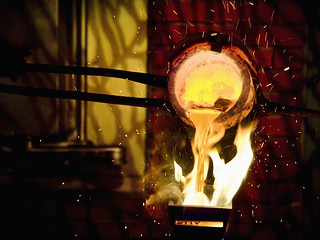
PREV ARTICLE
NEXT ARTICLE
FULL ISSUE
PREV FULL ISSUE
ROYAL MINT MISHAPSDavid Pickup submitted this article on some mishaps at the Royal Mint. Thanks! -Editor Danger at the Mint Continuing the series on coins and health, this time I want to look at the conditions mint workers experienced to produce coins.
One man had serious burns on his feet. History does not record what became of men, whether they lived or died or whether they could work again. This was an age of very little if any protective equipment. In the Victorian period the working conditions associated with the machinery must have been noisy, hot and unpleasant. In medieval times coin making was done by hand and brute force. The men were probably only paid by the quantity produced and only made when coins were required. One reference states that that mint workers were often agricultural labourers working near their homes outside the walls of the City of London in the surrounding villages. Men may have preferred to work in daytime and in the Summer when the natural light was better and fingers were not numb with cold. The Mint was hot and noisy and the buildings at The Tower were poorly maintained. The atmosphere was full of poisonous chemicals and gas produced by the metal working. Acid was used in the process and the raw metals would contain dangerous impurities. Making coins is basically cutting and shaping metal and hitting things hard and accurately. A miss-strike might mean a poorly struck coin or the loss of a finger or hand. If you think about the working conditions the men endured we would probably not complain about an off-struck coin or a double strike. For a discussion of a more deliberate death-by-gold, see:
To read David's earlier E-Sylum articles, see:
 Wayne Homren, Editor The Numismatic Bibliomania Society is a non-profit organization promoting numismatic literature. See our web site at coinbooks.org. To submit items for publication in The E-Sylum, write to the Editor at this address: whomren@gmail.com To subscribe go to: https://my.binhost.com/lists/listinfo/esylum All Rights Reserved. NBS Home Page Contact the NBS webmaster 
|
